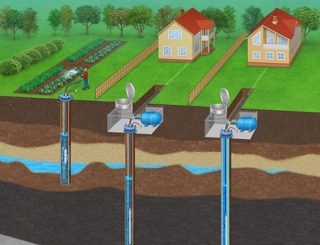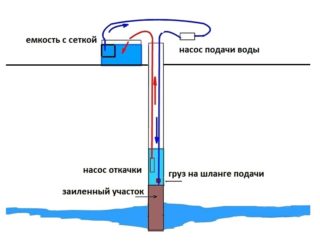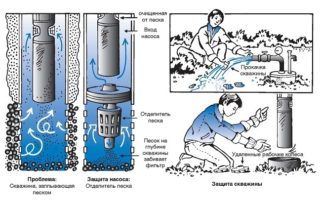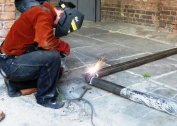Sometimes water disappears in a drilled well. A similar situation may arise with the newly made owner of a private house or cottage. First of all, you need to understand the reasons and try to solve the problem with minimal cost.
Reasons for shallowing of the well
Lack of fluid in the intake source or low head can be caused by many factors. The most difficult thing is to rectify the situation if, initially, a place was chosen incorrectly for a hydraulic structure without taking into account groundwater. If their volume is small, or there is a serious seasonal fluctuation in the filling, the well will be shallow.
Other causes of loss or lack of water in the well:
- mine pollution;
- casing installation errors;
- infrequent use of water intake;
- simple hydraulic construction in winter;
- incorrect selection of equipment.
Sometimes the reason that the fluid in the well runs out is the drying out of the water core or the abundance of water intakes in one area.
If the pressure device is not suitable for power and performance, it simply can not pump the right amount of fluid or create the necessary pressure. The solution to this problem is simple: replacement of pumping equipment.
It is much more difficult if mistakes are made during drilling, for example, few flowing holes are drilled at the depth of the aquifer or they are not large enough in diameter. Because of this fluid, it is difficult to penetrate into the trunk. Will have to create a new well or reconstruct an existing one.
If the water flows unevenly, periodically ends, and then flows again, the problem may be in the poor tightness of the main pipeline from the source to the pumping equipment or from the pump to the place of consumption. “Jolted” water supply may be due to breakage of valves on the main or booster pump, clogged filter or insufficient immersion of the pressure unit.
Ways to solve the problem
Measures are taken depending on the reasons for which there is no water. The most difficult thing is if the mine was drilled and at the same time did not take into account the features of groundwater.
Most likely, there will be a need for its transfer or deepening, which costs money.
In order to prevent the same mistake, it is necessary to conduct a preliminary study of the aquifers in the area and determine the most suitable place for the new water intake and its depth.
How to cope with other problems of downhole shallowing:
| Cause | Characteristic signs | Solutions |
| Clogging | Small particles of silt and sand cover the bottom and openings for fluid flow. | Clean using a water hammer. The method involves pumping a significant amount of water under pressure into the well shaft. Additionally, chemicals are added to it that destroy solid particles of contaminants. After cleaning, it will take some time to pump out water to remove impurities. |
| High casing installation | Water accumulates at the bottom, while freely moving through the water reservoir and does not form a reserve. | Deepen the well shaft and install additional pipe segments. |
| Infrequent use of the well | The place where the accumulation of water is filled with earth. As a result, there is a decrease in the space under the liquid. | Flush the trunk of the hydraulic structure and continue to use it continuously. With regular water intake, small particles are quickly washed out and do not cause a rise in the bottom level. |
| Use of many water points at once | The water stream does not have time to regenerate and fill all the trunks or to feed all consumers. | Limit the extraction of water from the bowels or mothball additional mines, if there are any nearby. |
| Source drying | The flow of water becomes smaller, the liquid becomes cloudy, thick and oily. | Deepen the shaft with a filter pipe or digging. It is also possible to drill a new spring near the old one, but much deeper. |
If the hydraulic structure created in sandy soil has become shallow, drilling of an existing well is possible. The reason for the loss of fluid here is the unstable location of the soil, and therefore the bulk of the water goes into neighboring cavities.
If the water is over due to the fact that the well is filled with mud and sludge, you can pump out the sediment with a choke. This is a metal device of a cylindrical shape, with the help of which they draw out pollution. You can buy it or make it yourself.
Scoop out dirt using a chipper as follows:
- The device is lowered to the bottom of the well on a strong cable.
- Raise it about half a meter several times and drop it down.
- When the bailer is filled with sediment, it is lifted and cleaned.
- Repeat the cycle until completely cleansed.
Next, you need to pump the well with a pump until clean water appears. If after cleaning the flow rate does not increase, you will have to clean or change the filter.
Hydropneumatic flushing is a good way to restore water in a mine shaft. The method is quite complicated and is done only by professionals. To work, you need a powerful pneumatic compressor and a water pump. Contaminants are removed under the influence of air and water under pressure. In this case, it is necessary to provide a continuous supply of water flow to the well for flushing.
At home, two pumps are used for these purposes - submersible and surface. The latter will pump a stream of water from a pre-prepared container or column, the second will bring contaminated liquid to the surface.
Preventive actions

To ensure uninterrupted water supply, all risks must be foreseen at the design stage. Before drilling the main water source, create an exploratory well. It will show how deep the water layer lies, and will allow you to evaluate the soil.
To avoid problems with submersible pressure equipment, it is installed at a depth of 50 cm below the water mirror and at a distance of more than a meter to the bottom.
Other methods of preventing shallowing of the source include:
- the creation of two parallel columns in the water intakes on the sand;
- casing shallow wells with pipes up to 20 cm in section;
- installation of casing elements below the water level;
- creating a large number of perforations;
- the use of filters to prevent contamination from clogging the perforation;
- regular preventive pumping of the well.
If seasonal use is anticipated, it is important to properly preserve the hydraulic structure for the winter. To prevent freezing of the source of water intake, it is insulated with thermally insulating materials. The pipe is equipped with a heating wire - this will not allow it to freeze. The pressure device is removed and cleaned in a warm, dry room. If this is unrealistic, it is also insulated and covered so as to avoid the penetration of moisture.
If the water in the well installation ends quickly, and the hydraulic structure does not provide uninterrupted supply to the house, do not rush to drill a new source. Probably, after eliminating the problems, the well will last a very long time.





